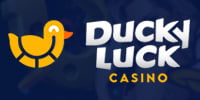How to Play Online Blackjack
How to play online blackjack? Follow the interactive step-by-step below to pick up the basics fast. We’ll also cover basic strategy, tips to win, payouts, odds of winning, and more along the way.
Tap the Fullscreen icon for a better view of the demo.
Play Online Blackjack for Free
You’ve seen the basics. Now, here’s a free blackjack game to practice and play at your own pace.
Try Your Luck and Play Blackjack for Real Money
How to Play Online Blackjack
If you’d rather read, this step-by-step shows how an online blackjack hand works from start to finish.
Place Your Initial Bet
Each player places a bet on the table before the cards are dealt.
This wager goes in a small circle in front of the chip stack called the betting area. Each table has a minimum and maximum bet size.The Dealer Deals The Cards
After all the bets are on the table, the dealers give each player two cards and deal two cards to themself.
Player cards are both dealt face up while the dealer cards are dealt one face up and one face down. The face-down card is called the hole card.Players Make Their Decisions
At this point, each player decides what they want to do with their hand. This step is where you choose to stand, hit, split, double, surrender, or take insurance.The Dealer Plays Out Their Hand
Once all players are done making decisions, the dealer plays their hand. They have no options and must follow the table rules. If their hand is less than 17, they must hit.
Some casinos have different dealer rules for soft vs. hard 17.Winners & Losers Are Decided
If the player beats the dealer, they get a 1 to 1 payout. If you win with a natural 21, the payout is 3 to 2. When a player busts, they lose. When a person doesn’t beat the dealer, they lose.
If you and dealer have the same total, the hand is called a push or a tie. In the case of a push, no money is won or lost.
Blackjack Basic Rules
The objective is to beat the dealer’s hand by scoring 21 or as close to 21 as possible without going over. When any hand goes over 21, that is called a bust.
The goal is to beat the dealer and not bust. You can do this in two ways:
- Have a higher hand than the dealer.
- Don’t go over 21 when the dealer does.
Blackjack Card Values
All of the face cards and 10s get a value of 10. Aces can be 1 or 11, depending on the situation.
Every other card is worth its face value. If you have a seven and a six, you have a total of 13. A Blackjack occurs when you have an Ace and any 10 valued cards.
This combo is also known as a natural 21.
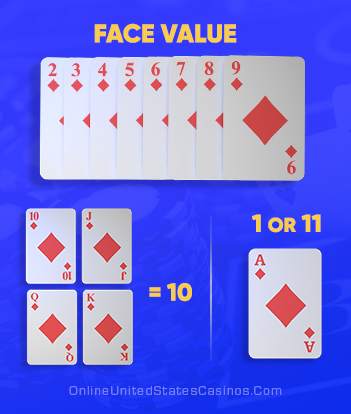
Blackjack Terms You Need to Know
Here are some basic terms you’ll see when playing blackjack online:
- Hit: Take another card.
- Stand: Keep your current hand.
- Bust: Go over 21 and lose the hand.
- Push: Tie with the dealer, and your bet is returned.
- Blackjack: An Ace and a 10-value card. Best hand in the game.
- Double: Double your bet and take one more card.
- Split: If you have two cards of the same value, you can split them into two hands.
- Soft hand: A soft hand is one where the ace is worth one. For example, when you have an ace and a six, you have a “soft 17.” The value of the soft hand is that it can’t bust.
- Hard hand: If you don’t hold an ace, then it’s a hard hand. If you’ve received a third card with a value of 12 or more, the hand is hard. These hands have no room for error because they can bust on the next card.
Blackjack Bets & Options
At the basic level, online blackjack is a game of math and statistics. A running formula can determine the best play for every turn.
Gamblers rely on these main actions to win against the dealer.
Hit or Stand
A hit is when you take another card to improve your hand. But if you like the cards you have, then you stand and don’t take any more cards.
Split
You can split if you receive two cards of the same rank. This divides the two cards into separate hands. You could also re-split, giving you three hands to play.
Doubling
Your next choice may be to double down, which means you double your bet after the initial deal if you think you can win with the next card.
Surrender
Some tables offer this option after the initial deal. If you think you have little chance of winning, you can surrender your hand and keep half of your bet.
Online Blackjack Strategy
Using this blackjack strategy chart will give you the correct play in any situation. So, before you practice your first hand, print or screenshot our free strategy table.
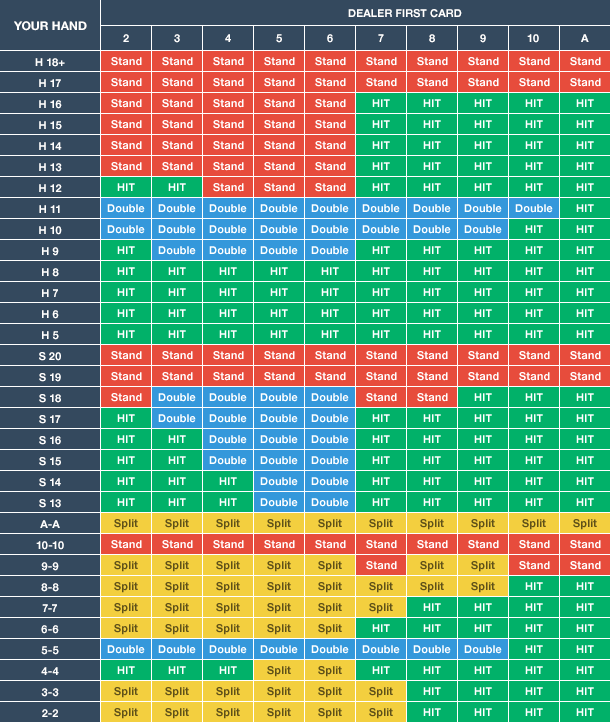
How to Read the Card
This blackjack strategy table has your starting hand in the left column and the dealer’s first card in the top row. You can find the best play for each hand in the spot where the two cross on the chart.
 Hit means to take a single additional card.
Hit means to take a single additional card. Double means to double down. This move doubles your wager.
Double means to double down. This move doubles your wager. Stand means take no more cards.
Stand means take no more cards. Splitting creates two hands from a pair. This move also doubles your wager.
Splitting creates two hands from a pair. This move also doubles your wager. The H stands for a hard hand. So, H5 is a three and a two.
The H stands for a hard hand. So, H5 is a three and a two. The S is a soft hand where an ace is 11. When the ace is a one, you have a hard hand.
The S is a soft hand where an ace is 11. When the ace is a one, you have a hard hand.
How to Use the Chart as a Cheat Sheet
You can use this blackjack chart as a cheat sheet to play strategically. But, how does it work? Here’s an example: if you have a six and a seven, and the dealer shows a seven, you should do the following:
6 + 7 = 13, so you go down the chart’s left side and look for H13 (This hand is “hard” since no ace has an 11 value).
- Move across the row to where the dealer has a 7, and you see the correct play is to Hit. Notice that if the dealer had a 6 instead of a 7, the right choice is to stand.
Online Blackjack Strategy for Each Hand
Here are all the best blackjack strategies based on the statistics. If you follow these rules, you’ll reduce the house edge and have a better chance of winning.
Below are the hands you’ll see most often. Use this guide to determine when to hit, stand, split, and double.
When to Split Pairs
- Pair of 2s, 3s, or 7s: Split against a dealer 7 or lower, and Hit against an 8 or higher.
- Pair of 4s: Split against a dealer 5 or 6, and Hit against anything else.
- Pair of 5s: Don’t Split. Instead, double against a 2-9, and Hit against a 10 or Ace.
- Pair of 6s: Split against a dealer 6 or lower, and Hit against a 7 or higher.
- Pair of 8s: Split against a dealer 9 or lower, and Hit against a 10 or Ace.
- Pair of 9s: Stand against a dealer 7, 10, or Ace, and Split against all other cards.
- Pair of 10s: Always stand with these hands regardless of the dealer’s cards.
- Pair of Aces: Always split these hands regardless of the dealer’s cards.
If You Can’t Double After Splitting
- Pair of 2s or 3s: Hit if the dealer shows a 2 or 3.
- Pair of 4s: Hit if the dealer has a 5 or 6.
- Pair of 6s: Hit if the dealer has a 2.
Hard Hand Decisions
- Hard 5, 6, 7, or 8: Always hit these hands regardless of the dealer’s cards.
- Hard 9: Double Down if the dealer has a 3, 4, 5, or 6. Otherwise, you Hit.
- Hard 10: Double Down unless the dealer shows a 10 or Ace, then you Hit.
- Hard 11: Double Down unless the dealer has an Ace up, then you Hit.
- Hard 12: Stand against a dealer’s 4, 5, or 6, and Hit against all other cards.
- Hard 13, 14, 15, or 16: Stand against a dealer 2 through 6 and Hit against a 7 or higher.
- Hard 17+: Always stand with these hands regardless of the dealer’s cards.
Soft Hand Plays
- Soft 13 or 14: Double against a dealer 5 or 6 and Hit against all other cards.
- Soft 15 or 16: Double against a dealer 4, 5, or 6, and Hit against all other cards.
- Soft 17: Double against a dealer 3 through 6 and Hit against all other cards.
- Soft 18: Stand against a 2, 7, or 8, Double against a 3-6, and Hit against a 9, 10, or Ace.
- Soft 19 or 20: Always stand with these hands regardless of the dealer’s cards.
Hand Surrender Strategy
- Hard 15: Surrender if the dealer shows a 10.
- Hard 16: Surrender if the dealer shows a 9, 10, or Ace.
Best Hand in Blackjack
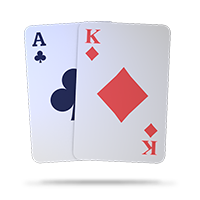
The best Blackjack hand is a two-card 21, meaning an ace and a card with the value of 10. That means King, Queen, Jack, or Ten.
When you receive a two-card 21, it’s called a Blackjack or a “natural Blackjack.” This hand beats every other hand in the game.
Worst Hand in Blackjack

The worst Blackjack hand is 16. If you stand, you face high odds that the dealer will have a stronger hand. If you hit, you face high odds that you’ll bust.
This is why you should always split 8s – not because of the strength of a hand worth 8, but because you avoid the worst hand.
Best Hands to Split
Always split aces and 8s in Blackjack. Roughly one-third of all cards in a deck have a value of 10. If you split aces, this means you have two excellent chances at a 21.
Also, since 16 is a lousy hand, you split the 8s to give yourself two opportunities to improve on 16. 18s aren’t perfect, but they win more hands than 16s will.
Finally, while splitting other numbers depends on the dealer’s up-card, you should never split tens, fours, or fives.
Two tens are a good hand, two fives equal ten, and two fours equal eight, so these have better chances of winning than most other hands.
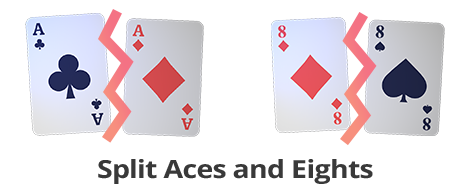
Online Blackjack Tips to Play
Remember, the rules may vary from one blackjack table to another. Here are some tips you should take into account when playing.
Stick to Your Budget:
Set a budget for each session and never exceed it. This helps manage your bankroll and prevents overspending.Use Basic Strategy:
Always follow the basic strategy chart to make optimal decisions for each hand. This reduces the house’s edge and improves your chances of winning.Avoid Side Bets:
Blackjack side bets usually have a high house edge. While they might be fun, they are not favorable in the long run.Take Breaks:
Regular breaks help you stay focused and avoid fatigue, leading to better decision-making.Don’t Chase Losses:
Avoid the temptation to increase your bets to recover losses. Stick to your strategy and betting limits.Stay Focused:
Alcohol and distractions can impair your judgment. Stay focused to make the best decisions.
Common Mistakes to Avoid in Blackjack
- Ignoring Basic Strategy: Not following the strategy chart increases the house’s edge and leads to poor decisions.
- Overestimating Card Counting: Relying solely on card counting without mastering basic strategy can result in mistakes and losses.
- Chasing Losses: Increasing bets to recover losses often leads to larger losses. Stick to your betting limits.
- Taking Insurance: Generally, a bad bet that rarely pays off and increases the house’s edge.
- Playing When Tired or Distracted: Fatigue and distractions lead to poor decisions. Stay focused and well-rested.
- Not Managing Bankroll: Failing to set and stick to a budget can result in overspending and significant losses.
- Misunderstanding Game Rules: Not fully understanding the rules can lead to costly mistakes. Learn the specific rules of the game you’re playing.
Advanced Blackjack Strategies (Proceed with Caution)
Once you’re good with basic strategy, you can learn advanced blackjack techniques to get better results. These include ways to manage your bets and handle streaks.
Note: Not all of them work online. For example, card counting won’t help against online games that use random number generators.
Card Counting
Card counting assigns a value to each card in an attempt to predict the next card in line. We have an entire page dedicated to counting cards in blackjack.
Remember, without a basic strategy, counting cards is useless.
Most online casino software shuffles after each hand, making card counting impossible. These tactics should be reserved for live dealer online games or brick-and-mortar casinos.
Martingale Betting Strategy
This involves doubling your bet after losing and reverting to your original wager after winning.
For instance, if you lose $1 on your first hand, you bet $2 on your next. If you lose the second, bet $4 on the next hand, and so on. Then after you win, you return to your original $1 bet. If you play this system, be aware of the table betting limits and bring a lot of money to play in losing streaks.
Play at Tables With Fewer Decks
Blackjack has one of the best odds of all casino games. With the right rules and proper gameplay, you can reduce the house edge to below 1%.
The house edge is a percentage of what players will lose over time. Tables with smaller decks and 3:2 blackjack payouts have a better player advantage. You have the best odds when you play with fewer decks in the shoe.
Ace Sequencing
Ace sequencing is related to shuffle tracking. This technique tries to determine when the aces will be dealt. The idea is to remember “key cards” that go on top of the ace in the discard rack, and after the shuffle when you see those key cards come out together you make a large bet hoping to catch the ace.
If you start tracking the number of Aces played versus the number of cards left, you have a better idea of when one is coming up.
Odds of Winning at Online Blackjack
Before playing your first hand, understand that the house edge always gives the advantage to the dealer. The player’s odds of winning a hand of blackjack are 42.22%, while the dealer has a 49.1% chance to win.
The remaining 8.48% of hands will be a tie, also known as a push. These odds are based on a standard round and do not account for strategy or alternative pay structures, such as 6:5 payouts.
In the following sections, you’ll learn more about the probability of busting out and the odds of getting specific hands in a game.
Probability of Busting
If you want to improve your odds of winning, you need to start by understanding the probability of busting a hand. The charts below break down the probabilities of the player and dealer busting based on what they are holding or showing.
Player’s Hand Busting
This table will help you understand the likelihood of busting when hitting with various hands.
You can use this in conjunction with the dealer’s table to help decide whether to hit or let the dealer take the chance.
Please note that when you make a 21, that is considered an automatic win, or a push if the dealer also has 21. You are not allowed to hit on a 21.
| Hand Value | Probability The Player Busts |
|---|---|
| 11 or Lower | 0% |
| 12 | 31% |
| 13 | 39% |
| 14 | 56% |
| 15 | 58% |
| 16 | 62% |
| 17 | 69% |
| 18 | 77% |
| 19 | 85% |
| 20 | 92% |
| 21 | NA |
Dealer Busting
This table is helpful as it can help you make better decisions based on the dealer’s up-card. The probability of the dealer busting will differ from the player’s probability for multiple reasons.
First, the dealer’s odds are based on their upcard. Next, dealers have strict game rules they must adhere to. Lastly, the dealer acts after the player and can see the player’s result.
| Dealer’s Card | Stand On Soft 17 | Hit on Soft 17 |
|---|---|---|
| Ace | 17% | 20% |
| 2 | 35% | 36% |
| 3 | 37% | 38% |
| 4 | 40% | 40% |
| 5 | 42% | 42% |
| 6 | 42% | 44% |
| 7 | 26% | 26% |
| 8 | 24% | 24% |
| 9 | 23% | 23% |
| 10 | 23% | 23% |
Online Blackjack Payouts
The payout structure is important because it directly influences the house edge and the overall odds of winning.
The better the payout structure, the lower the overall house edge, assuming you’re playing with proper strategy and avoiding side bets. By picking favorable payout structures, you put yourself in the best position to win the game.
General Blackjack Payouts Table
| Outcome | Payout | Example Bet | Example Winnings | Total Return |
|---|---|---|---|---|
| Blackjack | 3:2 (1.5x) | $10 | $15 | $25 |
| Standard Win | 1:1 | $10 | $10 | $20 |
| Tie (Push) | Bet Returned | $10 | $0 | $10 |
| Insurance | 2:1 | $10 + $5 | $5 | $10 |
Different Possible Payouts for Getting a Blackjack
3:2 Payout
This is the traditional payout structure, paying 3 to 2, or 1.5x your bet on a blackjack hand.
For example, if you bet $10, a blackjack will pay $25. The house edge in this game is between 0.5% and 1.5%.
6:5 Payout
This structure is becoming more popular at casinos as it has a higher house edge.
A blackjack pays 6 to 5, or 1.2x your bet. For example, if you bet $10 and hit Blackjack, you get $22. The house edge is between 2% and 3% on 6:5 games.
2:1 Payout
In some very rare instances, you may find a table paying 2:1 on a blackjack.
In this case, a $10 bet will return $30 on a blackjack. This actually puts the edge slightly in the player’s favor.
FAQs
Here are some common questions about playing blackjack online that you might not find in regular guides.
Can I play online blackjack for free before using real money?
Yes, most online casinos let you play free demo versions. It’s a good way to practice without risking anything.
Does online blackjack shuffle the cards after every hand?
Yes, in most online blackjack games the software reshuffles the deck after every hand. This keeps the game random and means card counting doesn’t work.
Can I use a strategy chart while playing online blackjack?
Yes, you can. Since you’re playing on your own screen, you’re free to keep a strategy chart open as you play.
Is online blackjack slower or faster than playing at a casino?
It’s usually faster. There’s no dealer shuffling cards or other players slowing down the game.
Do online blackjack games have table limits?
Yes, just like in a casino, online games have minimum and maximum bets. You’ll see the limits before you start playing.
What happens if I lose internet connection during a hand?
Most online casinos will save your progress. When you reconnect, you’ll pick up where you left off or see the result of the hand.
Are the odds in online blackjack the same as in a casino?
They’re close, but it depends on the rules of the game. Look for games with fewer decks and 3:2 payouts for better odds.
Can I play multiple hands at once in online blackjack?
Yes, some online blackjack games let you play more than one hand at a time. This speeds up the action but can also raise your risk.

